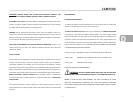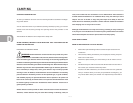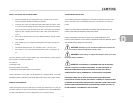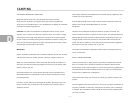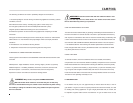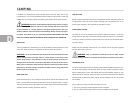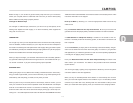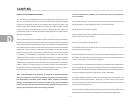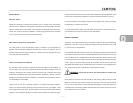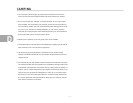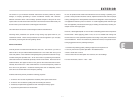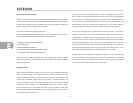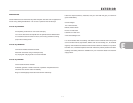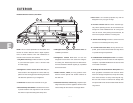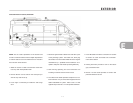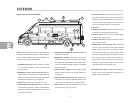
D
D - 10
CAMPING
ABOUT MOLDS
What are molds?
Molds are microscopic organisms that naturally occur in virtually every environment,
indoors and out. Outdoors, mold growth is important in the decomposition of plants.
Indoors, mold growth is unfavorable. Left unchecked, molds break down natural ma-
terials, such as wood products and fabrics. Knowing the potential risks is important
for any type of homeowner to protect their investment.
What factors contribute to mold growth?
For mold growth to occur, temperatures, indoor or outdoors, must be between 40
degrees and 100 degrees Fahrenheit and also have a source of moisture, such as
humidity, standing water, damp materials, etc. Indoors, the most rapid growth occurs
with warm and humid conditions.
How can mold growth be inhibited?
By controlling relative humidity, the growth of mold and mildew can be inhibited. In
warm climates, use of the air conditioner will reduce the relative humidity. Vents are
located in the bathing and cooking areas and constant use is advised during food
preparation and bathing, even during colder weather. Additionally, opening a window
during these activities will assist in ventilation. In extremely humid conditions, the use
of a dehumidifier can be helpful.*
Frequent use of your RV or cleaning regularly is an important preventive measure.
Further, any spills should be wiped up quickly and dried as soon as possible. Avoid
leaving damp items lying about. On safe surfaces, use mold or mildew killing cleaning
products. Check sealants regularly, and reseal when necessary to avoid water leaks.
Proper preventive maintenance to the RV and its accessories, as described both in this
manual and in accompanying literature, will provide the best protection to the RV.
For more information of controlling moisture in the RV, please read, “Tips to Controlling
Condensation,” located in this manual.
*If using a dehumidifier, please read and follow all manufacturer instructions and rec-
ommendations to the use and cleaning of the dehumidifier.
WINTER TRAVELING
Traveling in your motorhome during the cold winter months can be a most exhilarating
experience. There are, of course, certain precautions that must be taken as you would
in your home in low temperatures.
The Interstate Rear Bath motorhome has 12-Volt heat pad installed with the gray/black
combination-holding tank and the Interstate Mid Bath has the heat pad on the gray
tank. The black tank on the Mid bath model is above the floor allowing heat from the
furnace to protect it from freezing. This switch for the heating pad is located next to the
monitor panel. To conserve battery power, RV antifreeze may be used to protect the
gray/black tank. Battery power will last about 6 hours unless the unit is plugged into a
110-volt shoreline source to operate the converter/battery charger.
WARNING: Always shut off the LP gas when gasoline is added to the
fuel tank.
Some states do not allow LPG to be turned on while moving. While traveling in these
states you must use your common sense. How cold is it? How long will it be before
you can turn the heat back on? Is the temperature dropping or rising? Remember, the
wind chill factor when driving 50 MPH will cause the interior of the motorhome to cool
much faster than when it is parked.



